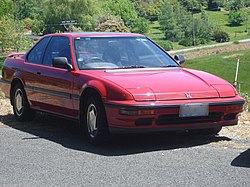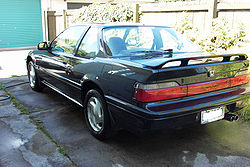The Honda Prelude was a sports coupe produced by Japanese automaker Honda from 1978 until 2001. It replaced the Honda S800, a front-engined, front-wheel drive sports car. The two-door coupe spanned five generations and was eventually discontinued upon the release of the fifth-generation Honda Integra or Acura RSX Type-S in North America in late 2001 as well as the release of the Honda S2000 in early 1999, due to its decreasing sales and popularity. In the U.S. auto market, the sixth-generation and subsequent Accord Coupes became the de facto replacement for the Prelude.
The Prelude's perennial competitor has been the Toyota Celica,[citation needed] another straight-4-powered coupe introduced several years prior to the Prelude. Throughout the 1980s, the Prelude was challenged by the Nissan Silvia, Isuzu Impulse, Mitsubishi FTO,Mitsubishi Cordia (later the Eclipse), Opel Manta/Opel Calibra, Ford Probe and Mazda MX-6.[citation needed] Out of all of these contemporaries, the Eclipse is the only car that remains in production.
 | |
| Production | 1988–1991 |
|---|---|
| Engine | 2.0L 104 hp (78 kW) I4 2.0L 135 hp (101 kW) I4 2.0L 140 hp (104 kW) I4 2.1L 140 hp (104 kW) I4 2.0L 142 hp (106 kW) I4 2.0L 150 hp (112 kW) I4 |
| Transmission | 4-speed automatic 5-speed manual |
| Wheelbase | 101 in (2,565 mm) |
| Length | 175.6 in (4,460 mm) (1988-89) 177.6 in (4,511 mm) (1990-91) |
| Width | 67.3 in (1,709 mm) |
| Height | 51 in (1,295 mm) (1988-89) 49.2 in (1,250 mm) (1990-91) |
| Curb weight | 2,337 lb (1,060 kg) - 2,954 lb (1,340 kg) (depending on model) |
The third generation Prelude (released in 1987 in Japan and a little later in some markets) was very similar in looks to the second generation. It was all-new, however, and gained four wheel steering on some models. In keeping true to the second generation Prelude's ideology, the third generaton received body changes that updated the look. New engines available in the USDM models were: in the 1988-1990 2.0S, the B20A3 which is a SOHC 12-valve dual-sidedraft carburetor engine displacing 1958 cc that produced up to 104 hp (78 kW) and 111 lb·ft (150 N·m); in the 1988-1991 2.0Si, the B20A5 with DOHC and PGM-FI that increased power to 135 hp (101 kW) and 127 lb·ft (172 N·m), or a slightly-larger B21A1 in 1990 and 1991 Si models described below. The B20A6 was the Australian model: a 2.0 DOHC 16-valve PGM-FI engine, also 1958 cc, producing 142 hp (106 kW) and 127 lb·ft (172 N·m).
| Engine List Honda Prelude: B20A/B20A1 - 2.0L DOHC PGM-FI 143/160 hp (Japan/Europe) B20A3 - 2.0L SOHC carb(12v) 104 hp Canada/US B20A4 - 2.0L SOHC carb(12v) Non US B20A5 - 2.0L DOHC PGM-FI 135 hp (101 kW) US B20A6 - 2.0L DOHC PGM-FI 142 hp (106 kW) Australia/New Zealand B20A7 - 2.0L DOHC PGM-FI 150 hp (110 kW) Europe B20A8 - 2.0L DOHC PGM-FI 133 hp (99 kW) Europe B20A9 - 2.0L DOHC PGM-FI 140 hp (100 kW) Europe B21A - 2.1L DOHC PGM-FI 145 hp (108 kW) Japan (SI States) B21A1 - 2.1L DOHC PGM-FI 140 hp (100 kW) Canada/US |
Design Aspects
The third generation Prelude also had some new external designs. The hood line was designed to be the lowest hood line of any front wheel drive car in the world, allowing for better forward visibility. The drag coefficient was at the very low rating of .34. This gave better fuel economy, lower wind noise, and a greater level of high-speed stability.
Another unique structural element of the third generation Prelude was the high-strength metal used in the six roof pillars. The roof pillars were so slim that all-around visibility was clear for 326°. Some called this Prelude the "baby NSX" when the NSX was introduced in 1990, due to some common design cues between the two cars. Excellent forward visibility via a low bonnet line, a front end resemblance, the suspension attributes (great handling with a smooth ride), and the new design of the rear lights could all be likened to the NSX.
In 1987, Road & Track published a test summary that shows the 1988 Honda Prelude 2.0Si 4WS outperforming every car of that year on the Slalom, including all Lamborghinis, Ferraris, and Porsches. It went through the slalom at 65.5 mph (105.4 km/h), an amazing result for the time. For reference, the 1988 Corvette took the same course at 64.9 mph (104.4 km/h).
The Prelude was Wheels magazine's Car of the Year for 1987.
1990
In 1990, the Honda Prelude was given a facelift from the previous third-generation styling to a newer look, chiefly in terms of the rear tail lights. The top of the rear bumper was also changed to meet up with the smaller lights, and the bumper was smoothed into a rounder shape. Outwardly, the Prelude resembled the Accord Coupe.
The front bumper on the 1990 Prelude was also changed to feature clear indicators and park lamps that no longer wrapped around the corners of the bumper. Many of the interior parts were revised, including the dash bezel, the door handle and window switches, the steering wheel shape contours, etc. The five-speed manual transmission had unique gear ratios that offered easy acceleration at high speeds. The B21A1 engine became available in the "Si" trim level, which offered 4WS or ABS (called ALB). The Japanese version of the Si with the B20A was rated 140 HP with the JDM engine and was rated for 37 MPG. The B21A5 engine bored to 83 mm (3.3 in) with a total displacement of 2056 cc producing up to 140 hp (104 kW). This version featured a unique cylinder liner that is reported to be extremely tough, but also contributes to additional oil consumption.
Honda released the Prelude SiStates in 1990. Originally available only in Japan, this car was a limited production run and very few were built. It featured four-wheel steering, ABS, limited slip differential, a leather-wrapped steering wheel and gear lever, extra sound deadening on the firewall and hood, rear windscreen wiper and washer, and many more features that were usually options. It also featured a unique B21A engine rated at 145 bhp (108 kW) that was only produced for the SiStates.
A series labeled INX was available on the Japanese domestic market. These models had fixed headlights (similar in nature to the European Accord Sedan from 85-90). It was available in three models: XX, Si and Si SRS.



